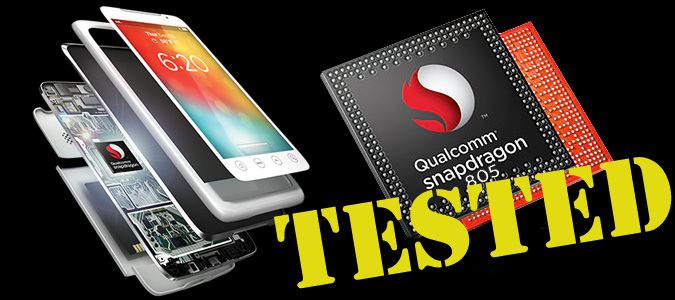Snapdragon 805 Benchmarked: Results vs Galaxy S5
Qualcomm’s Snapdragon 801 processor is just making its way into smartphones, but it’s already old news compared to the company’s upcoming Snapdragon 805 chip. Coming to devices later this year, the next-gen CPU offers a 40 percent graphics boost over the 801 and is the first chip that can natively display 4K content. We got some hands-on time with Qualcomm’s latest silicon beast and were impressed by what it has to offer.
To test its latest chip, Qualcomm let us benchmark one of its developer tablets running a 2.65-GHz version of the Snapdragon 805 with 3GB of RAM. Because the slate isn’t a finalized commercial product, its scores were slightly lower than those we’ve seen on the Snapdragon 801-powered Samsung Galaxy S5 and HTC One M8. Qualcomm, however, assured us that when the 805 makes its way into smartphones and tablets, it would easily outscore devices powered by its predecessors.
| Device | GeekBench 3 Multi-core (higher is better) | Quadrant (higher is better) | VidTrim (lower is better) | 3DMark Ice Storm Ultimate (higher is better) |
| Qualcomm Snapdragon 805 Developer Tablet | 2,779 | 24,324 | 4:25 | 19,801 |
| Samsung Galaxy S5 | 2,897 | 22,692 | 4:42 | 18,547 |
| HTC One M8 | 2,480 | 24,654 | 4:47 | 20,965 |
| Smartphone Category Average | 1,837 | 11,792 | 7:51 | 11,716 |
On the Quadrant benchmark, which tests a device’s overall system performance, the developer tablet registered a score of 24,324. That’s lower than the 24,645 we saw on the HTC One M8, but higher than the Galaxy S5’s score of 22,692. The smartphone category average clocked in at 11,792.
MORE: Top 10 Smartphones
On the Geekbench 3 benchmark, which tests a device's multicore processor performance, the Snapdragon 805-powered developer tablet scored a 2,779. That’s just below the Galaxy S5’s score of 2,897, but higher than the HTC One M8’s 2,480 and the smartphone category average of 1,837.
Benchmarks, however, don’t tell the whole story of what a processor can do. So to gauge the Snapdragon 805 developer tablet’s real-world performance we ran our Vidtrim transcode test, which involves timing how long it takes a device to transcode a 204MB, 1080p video file to 480p. The Snapdragon 805-powered tablet completed the test in just 4 minutes and 25 seconds, beating the HTC One M8’s time of 4:47 and the Galaxy S5’s 4:42. Each of the devices blew away the smartphone category average of 7:51.
Graphics and Gaming
Beyond a promised increase in overall system performance, the Snapdragon 805 also brings Qualcomm’s new Adreno 420 GPU to the table. The company says the chip will be a boon for mobile games as it is expected to offer performance increases as high as 40 percent over the Snapdragon 801’s Adreno 330 GPU, while consuming 20 percent less power.
Sign up to receive The Snapshot, a free special dispatch from Laptop Mag, in your inbox.
Additionally, the Adreno 420 offers DirectX 11 and OpenGL ES 3.1 support, as well as dynamic hardware tessellation and geometry shaders. All that basically translates to gamers getting console quality graphics on their mobile devices. We saw a demo of what the chip’s hardware tessellation is capable of and were blown away.
In the demonstration we were shown an animated hornet with the tessellation settings turned down. As such, the insect and its surroundings looked flat and lacked detail. When the tessellation was turned up, though, the Adreno 420 was able to add more polygons to the hornet and the rocky ground around making both come to life.
A second demo showing a close-up of a swimmer’s face bathed in the afternoon sun was meant to give us an idea of the kind of dynamic lighting and shadow effects the Adreno 420 can provide. When we moved the swimmer’s face the sunlight caused shadows from her nose to fall on her cheek. Similarly, when we moved the artificial sun, we were able to see how the Adreno 420 can refract light.
As with the system benchmarks we ran, however, the Snapdragon 805 and Adreno 420 offered lower test scores than we had hoped, topping out at 19,801 on the 3DMark Ice Storm Extreme test. That’s better than the Galaxy S5’s 18,547, but lower than the HTC One M8’s 20,965.
According to Qualcomm, as more graphics drivers are made available for the Snapdragon 805 and Adreno 420 GPU, benchmark scores overall gaming performance will improve dramatically.
4K Content
Of course, the big news about the Snapdragon 805 is its ability to display native 4K content. And though there aren’t many apps or movies available in 4K, they are coming. According to Qualcomm representatives, the company is actively working with developers to help them prepare 4K apps.
In one demo, Qualcomm helped illustrate how much better a 4K tablet display looks next to a 1080p panel. To do this, the company took an image with text multiple photos and pieces of text and displayed it on both a 1080p tablet and a 4K-enabled tablet. When viewed on the 1080p screen, many of the words appeared blurry to the point of illegibility. By contrast, text looked razor sharp on the 4K panel.
Outlook
Qualcomm’s Snapdragon 805 processor is shaping up to be quite an impressive piece of silicon. Although its benchmark numbers were a bit low during our demonstration, the company assures us that the chip will eventually outclass its predecessor. What’s more, the prospect of console quality graphics and native 4K content have us salivating for this CPU to hit the street. Thankfully, we won’t have to wait much longer, as we should start seeing devices with the 805 chip later this year.


